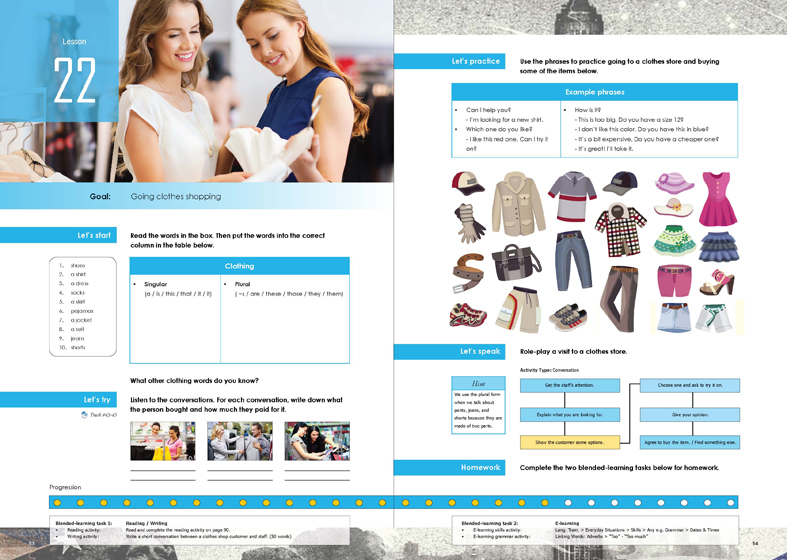
Manuals > General English > Rosetta Stone Advantage > Beginner - Book 1 > Lesson 22
< Previous Lesson | Next Lesson >

By the end of the lesson, the student should be able to go clothes shopping and interact with a sales clerk.
Communication strategies:
The student should be able to go shopping using the 6 steps below:
1) Get the staff’s attention.
2) Explain what they are looking for.
3) Ask about size and price.
4) Ask to try something on.
5) Give their opinion.
6) State they want to buy an item.
Words and rules:
The student should be able to name various items of clothing.
The student should be able to use singular and plural grammar.
The student should be able to use object pronouns. e.g. I'll take it. I'll take them.
Appropriateness:
Register: When talking to a sales clerk a polite register is usually used.
Social rules: When complaining, we usually say "a little" instead of "too". e.g. It's a little big = It's too big.
Cultural references: The student should be knowledgeable about regional differences in regards to what different pieces of clothing are called. e.g. slacks vs trousers
Track #43
I went clothes shopping last weekend. I bought a new shirt. It’s
yellow, my favorite color. It cost $25.
Track #44
I went to the clothes store on Sunday to buy a new suit. I bought a great suit with two pairs of pants. The total cost was $350.
Track #45
Last week I went to a department store. They were having a sale, so I bought this dress. It was only $75!
Because the lesson touches on the topic of shopping for clothes, you are welcome to introduce some of the following vocabulary if you like.
1) trainers (n)
2) a hoddie (n)
3) a singlet (n)
4) overalls (n)
5) a vest (n)
6) a blazer (n)
7) a uniform (n)
8) a blouse (n)
9) flip flops (n)
10) a swimsuit (n)
Option 1:
Difficulty ★
Type: Grammar - singular / plural
Purpose: To teach the student how to use singular and plural forms correctly.
Method: Brainstorm different articles of clothing, then state if they are singular or plural.
e.g. pants = plural / a shirt = singular
Show the student the following sets:
- Singular: a / is / it / it / this / that
- Plural: ~s / are / they / them / these / those
Then practice shopping for singular and plural items.
Option 2:
Difficulty ★★
Type: Grammar - relative clauses
Purpose: To teach the student how to describe the item they are looking for.
Method: Show the student that they can use a relative clause to describe what they are looking
for in more detail.
e.g. I’m looking for a dress.
e.g. I’m looking for a dress that has a flowers on it
Structure = Sentence 1 (THAT) (VERB PHRASE)
Option 3:
Difficulty ★★★
Type: Phrase introduction - Discounts
Purpose: To teach the student how to ask for a discount
Method: After the student has completed the basic role-play, teach them some basic
expressions they can use to get a discount.
e.g.
Can you give me a discount?
Can you know down the price?
Naruhodo point
Teach the student that demonstrative pronouns are usually only used once to refer to something. After you have mentioned something, it’s more common to use a subject or object pronoun when you refer to it again.
e.g.
A) How much is this?
B) It is $10.
A) I like it. Can I try it on?
Note: demonstratives = this / that / these / those
subject pronouns = it / they
object pronouns = it / them
Extra questions you might like to ask in the lesson
- Welcome to UniQlo. Can I help you?
- What are you looking for today?
- What kind of jacket would you like?
- What size would you like?
- Let me show you what we have.
- How about this one?
- Which one do you like?
- How do you like it?
- Would you like to try it on?
Let’s start
Read the words in the box. Then put the words into the correct column in the table below.
Singular
- a shirt
- a dress
- a skirt
- a jacket
- a suit
Plural
- shoes
- socks
- pyjamas
- jeans
- shorts
A) What other clothing words do you know?
B) A belt, jeggings, a scarf, overalls etc.
Let’s try
Listen to the conversations. For each conversation, write down what the person bought and how much they paid for it.
Track #43
She bought a new shirt it cost $25.
Track #44
He bought 3 pairs of socks and the total cost was $15.
Track #45
She bought a dress. It was only $75!
Let’s practice
Use the phrases to practice going to a clothes store and buying some of the items below.
A) Can I help you?
B) I’m looking for a new shirt.
A) Which one do you like?
B) I like this red one. Can I try it on?
A) How is it?
B) This is too big. Do you have a size 12?
A) Here you are.
B) How much is it?
A) Its $34.
B) Can I try it on?
A) Sure. How is it?
B) It’s great! I’ll take it.
Let’s speak
Role-play a visit to a clothes store.
A) Excuse me.
B) Hi. Can I help you?
A) Yeah. I’m looking for a new jacket.
B) What kind of jacket are you looking for?
A) A black leather one.
B) Here you are. We have lots of black jackets. Which one do you like?
A) This one is nice. Can I try it on?
B) Sure. How is it?
A) It’s very nice. I’ll take it.